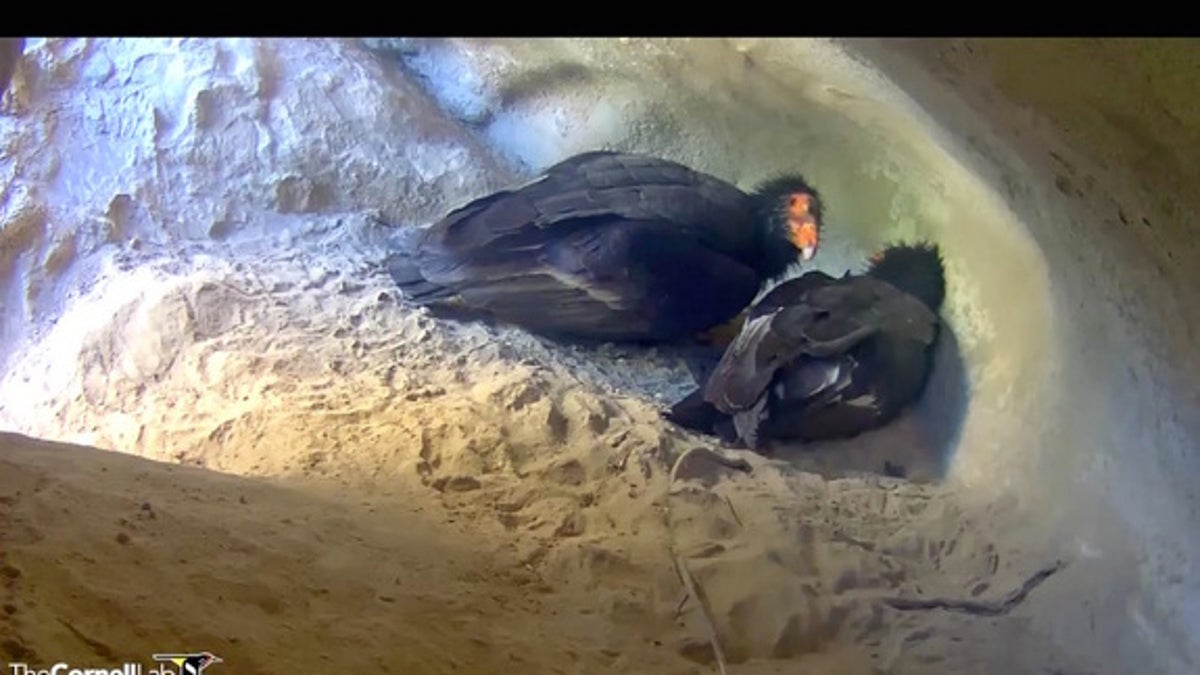
California condors #111 and #509 tend to their new chick. (Cornell Lab of Ornithology | Screen Shot)
After a California condor pair's egg went mysteriously missing in the middle of the night, the duo is back on track, raising a foster chick that biologists surreptitiously slipped into the birds' mountain nest.
The family affair began with condors #111, a 22-year-old female hatched at the San Diego Zoo Safari Park, and #509, a 7-year-old wild male. The two began courting in 2014, and nested together near the Hopper Mountain National Wildlife Refuge in southern California, according to the Cornell Lab of Ornithology.
Before long, #111 laid an egg. A team of U.S. Fish and Wildlife Service (USFWS) biologists snuck into the nest on March 2 to set up a bird cam and check the egg's viability with a candle test, in which a bright light is used to check the growing fetus inside. They reported that everything looked good, and estimated that the egg would hatch between April 4 and April 6. [10 Species You Can Kiss Goodbye]
But then, the egg went missing.
On the night between March 20 and March 21, it disappeared. In order to save battery power, the bird cam does not record during the night, so there's no proof of what happened to the egg. But, in all likelihood, a predator made off with it, leaving only a few eggshell fragments behind, according to the Cornell Lab of Ornithology, which runs the cam.
This development was worrisome to scientists, as the California condor (Gymnogyps californianus) is critically endangered, according to the International Union for Conservation of Nature (IUCN). In 2010, there were only 104 adult California condors of breeding age in the wild, and just 44 had produced surviving offspring, the IUCN said.
After the egg vanished, USFWS biologists devised an action plan: On March 21, they rappelled into the nest and replaced the missing egg with a dummy egg. Condor #111 entered the nest cavity just as they left, and — to everyone's relief — began incubating the fake egg.
Her partner, #509, incubated the dummy egg, too. In the meantime, the recovery team called the Los Angeles Zoo, which was raising eggs that condors had laid in captivity. The zoo gave one of its eggs to the USFWS scientists, who furtively rappelled into the nest again and swapped the dummy egg for the new foster egg on April 3.
The swap worked. The adults — which look a bit like hunchbacked, black umbrellas — incubated the egg, and it hatched on April 4, making it the first time that a condor chick had hatched live on a bird cam, according to the Cornell Lab of Ornithology.
It's unclear whether the 9-ounce chick is a male or female, but a blood test within its first year of life will clear that up. Once the chick turns 4 months old, biologists will tag it so that they can track it when it starts flying, at about 6 months of age.
For now, both #111 and #509 are taking turns keeping the chick warm and feeding it. Bird enthusiasts can watch the chick grow up on the California condor bird cam, and follow it on Twitter: @CornellCondors.
The biologists hope that the mystery thief responsible for the first egg's disappearance will leave the new chick alone.
"Sometimes, condors select nest cavities that are accessible to terrestrial predators that are skilled climbers, such as bobcats, black bears and mountain lions," the Cornell Lab of Ornithology said. "We will continue to closely monitor the condor nestling via the live streaming camera and newly placed motion activated Bushnell game camera that is capable of taking nighttime images."
Condor chicks remain dependent on their parents for more than a year, so birdwatchers will have plenty of time to watch the little chick grow up, the lab said.
- In Photos: Birds of Prey
- In Photos: The World's Freakiest Looking Animals
- Photos: World's Cutest Baby Wild Animals
Copyright 2016 LiveScience, a Purch company. All rights reserved. This material may not be published, broadcast, rewritten or redistributed.
